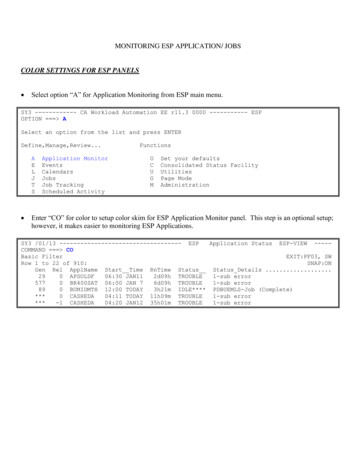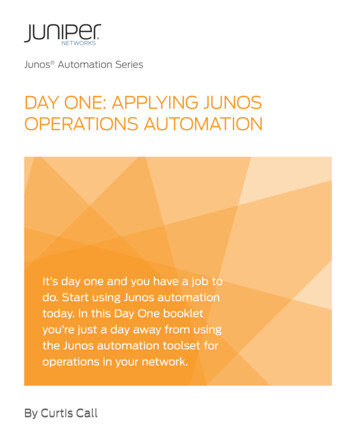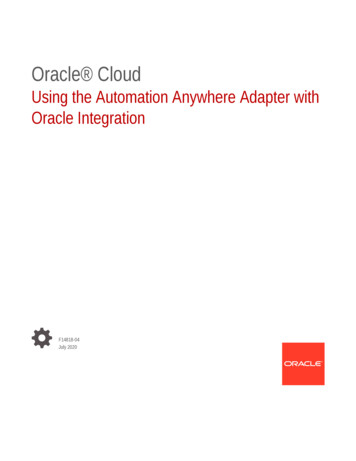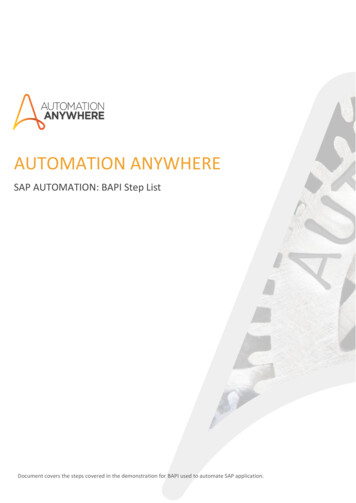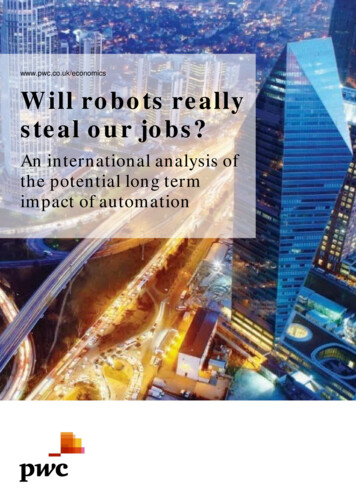
Transcription
www.pwc.co.uk/economicsWill robots reallysteal our jobs?An international analysis ofthe potential long termimpact of automation
Key findings: impact of automationFinancial services jobs could be relativelyvulnerable to automation in the shorter term,while transport jobs are more vulnerable toautomation in the longer termIn the long run, less well educated workerscould be particularly exposed to automation,emphasising the importance of increasedinvestment in lifelong learning and retrainingFigure 1 – Potential job automation rates byindustry across wavesFigure 2 – Potential job automation rates byeducation level across waves% of existing jobs at potential risk of automation50%% of existing jobs at potential risk of automationTransportFinancial servicesAll sectorsHealth40%Wave 1(to early 2020s)Low educationMedium educationHigh education30%Wave 2(to late 2020s)20%10%Wave 3(to mid-2030s)0%Wave 1(to early 2020s)Wave 2(to late 2020s)Wave 3(to mid-2030s)0%10%20%30%40%Source: PwC estimates based on OECD PIAAC data (median values for 29 countries)Source: PwC estimates based on OECD PIAAC data (median values for 29 countries)Female workers could be more affected byautomation over the next decade, but male jobscould be more at risk in the longer termWavesDescription and impactWave 1:Automation of simplecomputational tasks andanalysis of structured data,affecting data-driven sectorssuch as financial services.Figure 3 – Potential job automation rates bygender across wavesAlgorithmicwave (to early2020s)% of existing jobs at potential risk of automationWave 1(to early 2020s)Wave 2:MenAllWomenWave 2(to late 2020s)Wave 3(to mid-2030s)Augmentationwave (to late2020s)Wave 3:0%5%10%15%20%25%30%Source: PwC estimates based on OECD PIAAC data (median values for 29 countries)35%Autonomouswave (to mid2030s)50%Dynamic interaction withtechnology for clerical supportand decision making. Alsoincludes robotic tasks in semicontrolled environments such asmoving objects in warehouses.Automation of physical labourand manual dexterity, andproblem solving in dynamic realworld situations that requireresponsive actions, such as intransport and construction.
Will robots really steal our jobs?Contents1.Summary12.Introduction73.How do potential automation rates vary by country?93.1. Estimated potential automation rates across countries93.2. The relative impact of industry composition and job automatability103.3. Factors related to estimated automation levels113.4. Impact on countries over time – the three waves of automation143.5. Two important caveats – constraints on automation and new job creation174.Which industry sectors could see the highest rates ofautomation?184.1. Total automation rates across industries184.2. Impact on industries over time204.3. Drivers of differences between industries214.4. Which sectors are likely to see the largest jobs gains?225.23Which occupations could see the highest rates of automation?5.1. Total automation risk across occupation categories235.2. Impact over time by occupation245.3. Drivers of differences between occupations255.4. Composition of industries by occupational category266.Why does the potential rate of job automation vary by typeof worker?276.1. Total automation risk across workers276.2. Potential automation rates by education level307.34What are the public policy implications?7.1. Education and skills347.2. Job creation through increased public and private investment347.3. Enhancing social safety nets358. Implications for business: constraints, opportunitiesand responsibilities368.1. What constraints will need to be overcome to realise benefits for business?368.2. AI’s impact on company value chains378.3. AI and healthcare provision388.4. Businesses need to help workers retrain and adapt to new technologies398.5. Conclusion39Annex – technical methodology40References41Authors, contacts and services43An international analysis of the potential long term impact of automationPwC Contents
Will robots really steal our jobs?1. SummaryArtificial intelligence (AI), robotics and other forms of ‘smart automation’ are advancing at a rapid pace andhave the potential to bring great benefits to the economy, by boosting productivity and creating new and betterproducts and services. In an earlier study 1, we estimated that these technologies could contribute up to 14% toglobal GDP by 2030, equivalent to around 15 trillion at today’s values.For advanced economies like the US, the EU and Japan, these technologies could hold the key to reversingthe slump in productivity growth seen since the global financial crisis. But they could also produce a lot ofdisruption, not least to the jobs market. Indeed a recent global PwC survey 2 found that 37% of workers wereworried about the possibility of losing their jobs due to automation.To explore this further we have analysed a dataset compiled by the OECD that looks in detail at the tasksinvolved in the jobs of over 200,000 workers across 29 countries (27 from the OECD plus Singapore andRussia). Building on previous research by Frey and Osborne (Oxford University, 2013) 3 and Arntz, Gregoryand Zierahn (OECD, 2016) 4 we estimated the proportion of existing jobs that might be of high risk ofautomation by the 2030s for: Each of these 29 countries; Different industry sectors; Occupations within industries; and Workers of different genders, ages and education levels.We also identify how this process might unfold over the period to the 2030s in three overlapping waves:1.Algorithm wave: focused on automation of simple computational tasks and analysis of structured datain areas like finance, information and communications – this is already well underway.2. Augmentation wave: focused on automation of repeatable tasks such as filling in forms, communicatingand exchanging information through dynamic technological support, and statistical analysis ofunstructured data in semi-controlled environments such as aerial drones and robots in warehouses – this isalso underway, but is likely to come to full maturity in the 2020s.3. Autonomy wave: focused on automation of physical labour and manual dexterity, and problem solving indynamic real-world situations that require responsive actions, such as in manufacturing and transport (e.g.driverless vehicles) – these technologies are under development already, but may only come to full maturityon an economy-wide scale in the 2030s.Our estimates are based primarily on the technical feasibility of automation, so in practice the actual extent ofautomation may be less, due to a variety of economic, legal, regulatory and organisational constraints. Justbecause something can be automated in theory does not mean it will be economically or politically viablein practice.1234PwC, ‘Sizing the prize’ (2017): PwC, ‘Workforce of the future’ (2017): , C.B. and M.A. Osborne (2013), The Future of Employment: How Susceptible are Jobs to Computerisation?, University of Oxford.Arntz, M. T. Gregory and U. Zierahn (2016), ‘The risk of automation for jobs in OECD countries: a comparative analysis’, OECD Social,Employment and Migration Working Papers No 189.An international analysis of the potential long term impact of automationPwC 1
Will robots really steal our jobs?Furthermore, other analysis we have done 5 suggests that any job losses from automation are likely to bebroadly offset in the long run by new jobs created as a result of the larger and wealthier economy madepossible by these new technologies. We do not believe, contrary to some predictions, that automation will leadto mass technological unemployment by the 2030s any more than it has done in the decades since the digitalrevolution began.Nonetheless, automation will disrupt labour markets and it is interesting to look at the estimates we haveproduced to get an indication of the relative exposure of existing jobs to automation in different countries,industry sectors, and categories of workers. We summarise the key findings in these three areas in turn below.Potential impacts by countryAs Figure 1.1 shows, the estimated proportion of existing jobs at high risk of automation by the early 2030svaries significantly by country. These estimates range from only around 20-25% in some East Asian and Nordiceconomies with relatively high average education levels, to over 40% in Eastern European economies whereindustrial production, which tends to be easier to automate, still accounts for a relatively high share of totalemployment. Countries like the UK and the US, with services-dominated economies but also relatively long‘tails’ of lower skilled workers, could see intermediate levels of automation in the long run.Figure 1.1 – Potential job automation rates by country across wavesPotential jobs at high risk of nkisrchlsgpnorswenzljpnrusgrcfinkorAlgorithm waveAugmentation waveAutonomy waveSource: PIAAC data, PwC analysis5This modelling was described in our report on the global economic impact of AI here: n international analysis of the potential long term impact of automationPwC 2
Will robots really steal our jobs?Figure 1.1 also shows how potential automation rates might evolve by country over our three waves ofautomation. Existing jobs in some countries with relatively low longer term automation rates, such as Japan,may nonetheless be see relatively high automation rates in the shorter term given that algorithmic technologiesare already more widely used there.The opposite is true for a country like Turkey, which may have relatively high exposure to later waves ofautomation that start to displace manual workers such as drivers and construction workers, but relativelylower exposure in the short term.Potential impacts by industry sectorWe also see significant variations in potential automation levels between industry sectors, although the patternhere also varies across different waves as Figure 1.2 illustrates.Figure 1.2 – Potential rates of job automation by industry across wavesPotential jobs at high risk of automation0%10%20%30%40%50%60%Transportation and storageManufacturingConstructionAdministrative and support serviceWholesale and retail tradePublic administration and defenceFinancial and insuranceInformation and communicationProfessional, scientific and technicalAccommodation and food serviceHuman health and social workEducationAlgorithm waveAugmentation waveAutonomy waveSource: PIAAC data, PwC analysisTransport stands out as a sector with particularly high potential for automation in the longer run as driverlessvehicles roll out at scale across economies, but this will be most evident in our third wave of autonomousautomation (which may only come to maturity in the 2030s). In the shorter term, sectors such as financialservices could be more exposed as algorithms outperform humans in an ever wider range of tasks involvingpure data analysis.An international analysis of the potential long term impact of automationPwC 3
Will robots really steal our jobs?Potential impacts by type of workerOur analysis also highlights significant differences in the potential impact of automation across types of workersand these will also vary across our three waves of automation as Figure 1.3 shows.Figure 1.3 – Potential job automation rates by type of worker across wavesPotential jobs at high risk of automation0%10%20%30%40%50%SexMaleFemaleEducation levelAge groupYoung ( 25)Core (25-54)Older (55 )LowMediumHighAlgorithm waveAugmentation waveAutonomy waveSource: PIAAC data, PwC analysisThe starkest results are those by education level, with much lower potential automation rates on average forhighly educated workers with graduate degrees or above, than for those with low to medium education levels.This reflects the greater adaptability of more highly educated workers to technological changes and the fact thatthey are more likely to be in senior managerial roles that will still be needed to apply human judgement, as wellas to design and supervise AI-based systems. Such workers could see their wages increase due to theproductivity gains that these new technologies should bring.Differences are less marked by age group, although some older workers could find it relatively harder to adaptand retrain than younger cohorts. This may apply particularly to less well-educated men as we move into ourthird wave of autonomous automation in areas like driverless cars and other manual labour that has a relativelyhigh proportion of male workers at present. But female workers could be relatively harder hit in early waves ofautomation that apply, for example, to clerical roles.Implications for public policyThe most obvious implication of our analysis is the need for increased investment in education and skills tohelp people adapt to technological change throughout their careers. While increased training in digital skillsand STEM subjects 6 is one important element in this, it will also require retraining of, for example, truckdrivers to take jobs in services sectors where demand is high but automation is less easy due to theimportance of social skills and ‘the human touch’. Governments, business, trade unions and other organisations(e.g. the NHS and social care providers in the UK) all need to play their part here in helping people to adapt tothese new technologies 7. This will include training and retraining people in softer skills, such as creativity,problem solving and flexibility. On-the-job training will be important here, for example through degree67Design and other creative skills may also be important here.The recent UK government proposal in its November 2017 Budget for a new National Retraining Scheme involving both business andtrade unions is one example here. Further discussion of how people can be helped to adapt to new technologies is contained in ourWorkforce of the Future report here: https://www.pwc.com/futureworkforce.An international analysis of the potential long term impact of automationPwC 4
Will robots really steal our jobs?apprenticeships that offer a mix of theoretical study and practical experience, and that are open to a wide rangeof people (including mature students) to promote social mobility.In addition, it is important that aggregate demand levels are kept high so as to facilitate the creation of newjobs. One obvious way to do this at present is through increased infrastructure investment (including areas suchas housing where this is in short supply as in the UK). Such investment is needed to support longer termgrowth, but can also create many new jobs in construction and related sectors 8. Governments can play a keyrole here both in funding some investment directly and in helping to lever in additional private investment.It is also important to recognise that concerns about the possible loss of existing jobs should not lead countriesto miss out on opportunities to lead the way in developing these new technologies. If governments andbusinesses in one country do not invest in them, then they will just be developed elsewhere. Unless a countryblocks itself off from global trade and investment, which history shows would be extremely damagingeconomically in the long run, the technologies will still come to all countries over time, so it is better to be at theforefront of this global race.However, governments do have a key role in making sure that the great potential benefits from AI, robotics andrelated technologies are shared as broadly as possible across society. As well as investing more in education,training and retraining, and protecting workers rights through appropriate legislation, governments shouldconsider using the tax proceeds from technology-driven growth to strengthen social safety nets for those wholose out from automation.Universal basic income (UBI) is one idea that has been discussed here. The case for this remains to be proven,but it makes sense for governments to gather evidence from pilot schemes and microsimulation models toinform future decisions on this and other options for sharing the benefits of technology more widely acrosssociety. Optimal solutions here may involve combining different ideas (e.g. UBI-type schemes with a degreeof conditionality related to working, learning, training, caring or doing some other form of socially valuableactivity to qualify for such benefits).Implications for businessOur research on AI, robotics and related technologies shows their huge potential to boost productivity andcreate new and better products and services. There are large benefits to be reaped here by businesses in allsectors, but the phasing of these may vary across different waves of automation (see Table 1.1). Of course,many businesses will need to start investing now for later waves, but they also need to focus on the shortterm gains already available through emerging technology and algorithmic methods to enhance data analysisand customer service.Table 1.1: Key impacts in the three waves of automation8PhaseDescriptionTasks impactedIndustries impactedAlgorithmwaveAutomation of simplecomputational tasks andanalysis of structured data,affecting data-drivensectors such asfinancial services.This includes manually conductingmathematical calculations, or usingbasic software packages and internetsearches. Despite increasinglysophisticated machine learningalgorithms being available andincreasingly commoditised, it is thesemore fundamental computational jobtasks that will be most impacted first.Data driven sectors likefinancial and insurance,information andcommunication, andprofessional, scientificand technical services.Of course, as our analysis shows, some construction jobs may also be automated in the long run to boost productivity, but if moreconstruction work is undertaken this will also boost the demand for human labour, particularly in the short to medium term.An international analysis of the potential long term impact of automationPwC 5
Will robots really steal our jobs?PhaseDescriptionTasks impactedIndustries impactedAugmentationwaveDynamic interactionwith technology forclerical support anddecision making. Alsoincludes robotic tasksin semi-controlledenvironments suchas moving objectsin warehouses.For example, routine tasks such asfilling in forms or exchanginginformation, which includes thephysical transfer of information. It isalso likely to see a decreased need formany programming languages asrepeatable programmable tasks areincreasingly automated, and throughmachines themselves building andredesigning learning algorithms.The financial and insurancesector will continue to behighly impacted, along withother sectors with a higherproportion of clerical support,including public andadministration,manufacturing, andtransport and storage.AutonomywaveAutomation of physicallabour and manualdexterity, and problemsolving in dynamic realworld situations thatrequire responsive actions,such as in transportand manufacturing.AI and robotics will further automateroutine tasks but also those tasks thatinvolve physical labour or manualdexterity. This will include thesimulation of adaptive behaviour byautonomous agents.Sectors like construction,water, sewage and wastemanagement, andtransportation and storagewith the advent of fullyautonomous vehiclesand robots.Source: PwC analysisBusinesses also need to consider now how successive waves of AI-related technologies might further breakdown barriers to entry in their sector and challenge existing business models. In addition to enhancing existingpropositions, it also allows business to offer the same proposition in a more cost effective way, which may beparticularly beneficial for small to medium sized businesses and start-ups. This will also create newopportunities for successful businesses to leverage their distinctive competencies in adjacent sectors. Given thefast pace of change, businesses need to be constantly experimenting with new technologies and creating optionsthat they can scale up quickly where successful.Individuals also need to be more entrepreneurial, taking responsibility for their lifelong learning and seeking togenerate their own intellectual property and start new businesses. Much of the automation of the future may bedriven by these new businesses replacing or challenging established companies that find it harder to change.At the same time, as we have argued in previous reports 9, businesses and other employers need to adopt aresponsible approach to AI, both as regards their customers (e.g. as regards data privacy) and their workers(e.g. helping them to develop the skills they need to prosper in an age of increasing automation and rapidtechnological change).By acting in this way 10, businesses and governments can help to maximise the benefits of AI and robotics whileminimising as far as possible the negative impacts of these disruptive technologies.See our website for more details on Responsible AI: sible-ai/responsible-ai-framework.html.10 For more on this, see the following G20 Policy Insights paper by various PwC authors: http://www.g20insights.org/policy 9An international analysis of the potential long term impact of automationPwC 6
Will robots really steal our jobs?2. IntroductionThe potential for disruption to labour markets due to advances in technology is not a new phenomenon. Mostfamously, the Luddite protest movement of the early 19th century was a backlash by skilled handloom weaversagainst the mechanisation of the British textile industry that emerged as part of the Industrial Revolution(including the Jacquard loom, which with its punch card system was in some respects a forerunner of themodern computer). But, in the long run, not only were there still many (if, on average, less skilled) jobs in thenew textile factories but, more important, the productivity gains from mechanisation created huge new wealth.This in turn generated many more jobs across the UK economy in the long run than were initially lost in thetraditional handloom weaving industry.The standard economic view for most of the last two centuries has therefore been that the Luddites were wrongabout the long-term benefits of the new technologies, even if they were right about the short-term impact ontheir personal livelihoods. Anyone putting such arguments against new technologies has generally beendismissed as believing in the ‘Luddite fallacy’.However, over the past few years, fears of technology-driven job losses have re-emerged with advances in‘smart automation’ – the combination of AI, robotics and other digital technologies that is already producinginnovations like driverless cars and trucks, intelligent virtual assistants like Siri, Alexa and Cortana, andJapanese healthcare robots.While traditional machines, including fixed location industrial robots, replaced our muscles (and those of otheranimals like horses and oxen), these new smart machines have the potential to replace our minds and to movearound freely in the world driven by a combination of advanced sensors, GPS tracking systems and deeplearning - if not now, then probably within the next decade or two. Will this just have the same effects as pasttechnological leaps – short term disruption more than offset by long term economic gains? Or is this somethingmore fundamental in terms of taking humans out of the loop not just in manufacturing and routine servicesector jobs, but more broadly across the economy? What exactly will humans have to offer employers if smartmachines can perform all or most of their essential tasks better in the future 11? In short, has the ‘Luddite fallacy’finally come true?This debate was given added urgency in 2013 when researchers at Oxford University (Frey and Osborne, 2013)estimated that around 47% of total US employment had a ‘high risk of computerisation’ over the next couple ofdecades – i.e. by the early 2030s.However, there are also dissenting voices. Notably, Arntz, Gregory and Zierahn (OECD, 2016) re-examined theresearch by Frey and Osborne and, using an extensive new OECD data set, came up with a much lower estimatethat only around 10% of jobs were under a ‘high risk 12 of computerisation’. This is based on the reasoning thatany predictions of job automation should consider the specific tasks that are involved in each job rather thanthe occupation as a whole 13.In an earlier article in March 2017 14 we produced our own analysis of the potential effect of automation on jobswith a focus on the UK. Using a more refined version of the OECD methodology, we concluded that up to 30%of UK jobs could be impacted by automation by the 2030s. We also produced high level comparisons suggestingsomewhat lower potential automation rates in Japan and somewhat higher rates in Germany and the US.Martin Ford, The Rise of the Robots (Oneworld Publications, 2015) is one particularly influential example of an author setting out thisargument in detail. Calum Chace (The Economic Singularity, 2016) also discusses these issues in depth.12 In both studies, this is defined as an estimated probability of 70% or more. For comparability, we adopt the same definition of ‘highrisk’ in this report.13 The importance of looking at tasks is also emphasised by Autor (2015).14 ‘Will robots steal our jobs?’ PwC UK Economic Outlook, March 2017, available here: o-section-4-automation-march-2017-v2.pdf.11An international analysis of the potential long term impact of automationPwC 7
Will robots really steal our jobs?At the same time, we also emphasised that various economic, legal and regulatory and organisational factorsmean that these potential risks may not lead to actual job displacement. In some cases, it would alter the natureof jobs significantly, but not displace humans entirely.Furthermore, we emphasised that there were likely to be broadly offsetting job gains from the new technologies,provided that the income and wealth gains from these advances were recycled into the economy. Thisqualitative judgement was backed up by later detailed quantitative modelling 15 that concluded that the net longterm job impact of automation would be likely to be neutral or even slightly positive 16. This will, however,require both business and governments to provide support to workers affected by these technological advancesto retrain and start new careers.In this paper, we extend our March 2017 analysis of jobs at potential risk of automation to a much wider set ofcountries, using the OECD’s PIAAC database for 29 countries (27 from the OECD, plus Singapore and Russia).In total, this covers the jobs of over 200,000 workers and so provides a much larger dataset to explore potentialimpacts of automation by country, sector and type of worker. The additional data also allows us to provide amore robust analysis of the factors causing automation risk to vary across countries and sectors.We also identify how this process might unfold over the period to the 2030s in three overlapping waves:1.Algorithm wave: focused on automation of simple computational tasks and analysis of structured datain areas like finance, information and communications – this is already well underway.2. Augmentation wave: focused on automation of repeatable tasks such as filling in forms, communicatingand exchanging information through dynamic technological support, and statistical analysis ofunstructured data in semi-controlled environments such as aerial drones and robots in warehouses –this is also underway, but is likely to come to full maturity in the 2020s.3. Autonomy wave: focused on automation of physical labour and manual dexterity, and problem solving indynamic real-world situations that require responsive actions, such as in manufacturing and transport (e.g.driverless vehicles) – these technologies are under development already, but may only come to full maturityon an economy-wide scale in the 2030s.Report structureThe discussion in the rest of this report is structured as follows: Section 3 – How do potential automation rates vary by country? Section 4 – Which industry sectors could see the highest levels of automation? Section 5 – Which occupations could see the highest rates of automation? Section 6 – Why does the potential rate of job automation vary by type of worker? Section 7 – What are the public policy implications? Section 8 – Implications for business – constraints, opportunities and responsibilities.Further details of the methodology behind our analysis are contained in a technical annex at the end of thisreport, together with references to the studies cited.This modelling was described in our report on the global impact of AI here: 6 Other reports such as ZEW (2016) and Acemoglu and Restrepo (2016) also highlights the job creating potential of these newtechnologies. However, an empirical study for the US manufacturing sector by Acemoglu and Restrepo (2017) found a net negativeimpact on employment from industrial robots, so this remains an active area of debate.15An international analysis of the potential long term impact of automationPwC 8
Will robots really steal our jobs?3. How do potential automation ratesvary by country?Key findings The estimated share of existing jobs that could potentially be automated by the 2030s varies widely acrosscountries from only around 22%
An international analysis of the potential long term impact of automation PwC 1 . Artificial intelligence (AI), robotics and other forms of ‘ smart automation’ are advancing at a rapid pace and have the potential to bring great benefits to the economy, by boosting produc


